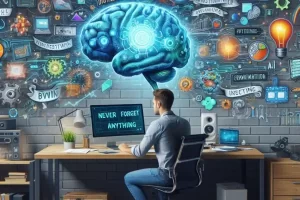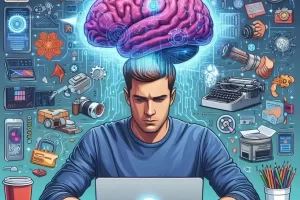Imagine having a digital space where everything you’ve ever learned, thought, or created is stored, searchable, and ready to be used — instantly. That’s exactly what a personal knowledge library offers when built inside your second brain and enhanced with artificial intelligence (AI).
In this article, you’ll learn how to build a smart, searchable, and ever-evolving knowledge library using your second brain and AI — so you never lose a valuable insight again.
What Is a Personal Knowledge Library?
A personal knowledge library is more than a notes archive. It’s a curated, connected, and growing body of knowledge that reflects:
- What you’ve learned
- How you think
- What you’re curious about
- What you’re building or teaching
It holds:
- Book notes and highlights
- Course summaries
- Research findings
- Personal insights
- Content drafts
- Frameworks and templates
And with AI, it doesn’t just sit there — it actively helps you think, write, and create.
Define the Purpose of Your Library
Before building, decide what your library is for:
- 🧠 Personal learning and growth?
- 📝 Content creation?
- 🎓 Teaching or coaching?
- 💼 Professional development?
- 💡 Idea generation?
This guides how you capture, organize, and retrieve knowledge.
Ask AI:
“Based on my recent notes, what knowledge themes do I revisit most?”
“Help me categorize my second brain into key domains of interest.”
Choose a Core Structure for Your Notes
Avoid the mistake of using random folders or unstructured lists. Build a structure around concepts and themes, not just sources.
Organize your notes into:
- Concepts (e.g., “Decision-Making,” “Storytelling,” “Productivity”)
- Principles (e.g., “Parkinson’s Law,” “80/20 Rule”)
- People (e.g., “Cal Newport,” “Naval Ravikant”)
- Mediums (e.g., Books, Podcasts, Courses, Articles)
Use Notion, Obsidian, or Tana to set up a linked database with AI helping you create and maintain structure.
Prompt examples:
“Group these 50 book notes into themes.”
“What tags should I use to organize these 10 research notes?”
Create Evergreen Notes with AI
Instead of having dozens of short, disconnected notes, use AI to help you transform them into evergreen notes — permanent, reusable entries that represent core ideas.
Each evergreen note includes:
- A summary in your own words
- A few key takeaways
- Related concepts or examples
- Links to original sources
Ask AI:
- “Turn these highlights into an evergreen note about Deep Work.”
- “What are the most important insights from my notes on motivation?”
- “Summarize these three book quotes into a single concept.”
Use AI to Link Ideas Automatically
Your second brain becomes more powerful when your ideas are connected. AI can help you:
- Suggest connections between old and new notes
- Create backlinks between concepts
- Highlight recurring patterns across time
Prompts to try:
“What notes relate to this new idea I just saved?”
“Create a list of all my notes that reference the concept of ‘focus’.”
“Which authors or ideas have influenced my thinking on creativity?”
This transforms your knowledge base into a living network, not a static archive.
Add Searchable Layers of Metadata
Make your knowledge library easier to explore by tagging notes with:
- Topic
- Source type
- Author
- Domain (Work, Life, Creativity, Health)
- Status (To Read, In Progress, Processed)
Use AI to generate this automatically:
- “Tag these 25 notes by domain and source.”
- “What metadata should I add to make this library easier to navigate?”
- “Create filters for my content based on energy level and reading time.”
Review and Update Notes Periodically
Your understanding evolves. So should your notes.
With AI, you can:
- Get summaries of notes you haven’t reviewed in months
- Merge outdated content into updated frameworks
- Highlight conflicting insights across time
Prompts:
“Which notes haven’t been touched in 6+ months?”
“Summarize and consolidate all my notes on time management.”
“How has my thinking on goal-setting changed over time?”
This ensures your library stays relevant and intelligent.
Turn Knowledge Into Action and Content
Your knowledge isn’t just for storage — it’s for doing.
Let AI help you convert stored knowledge into:
- Blog outlines
- Video scripts
- Workshop frameworks
- Project plans
- Coaching materials
Prompts:
- “Turn my notes on leadership into a 3-part blog series.”
- “Create a content calendar based on my knowledge tags.”
- “Draft a 5-step course outline based on my notes about learning techniques.”
Your second brain becomes your content engine.
Real-Life Example: The Creator’s Library
Let’s say you’re a creator learning and teaching productivity.
You build a library with:
- Summarized highlights from 30+ books
- Evergreen notes on concepts like “flow,” “attention,” and “systems”
- AI-generated links between authors like James Clear, Cal Newport, and Tiago Forte
- Tagged entries based on audience level (beginner, advanced)
- A dashboard showing your top 10 “ready-to-create” content ideas from your notes
Now your knowledge is organized, connected, and ready to serve your creative process.
Final Thoughts: Build the Library That Thinks With You
Most people lose 90% of what they learn. But you don’t have to. With an AI-powered second brain, you can build a personal knowledge library that:
- Grows with every idea
- Connects concepts across time
- Helps you create and teach
- Reflects how you think — and helps you think better
This isn’t just note-taking. It’s knowledge curation for lifelong leverage.
Start today. Capture with intention. Organize with clarity. Let AI connect the dots — and turn your learning into your legacy.




